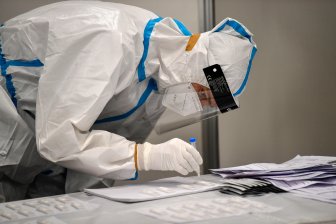St. Joseph’s Healthcare Hamilton hopes to raise $ 1.4 million to bring a CT scanner to its emergency department.
Adding a CT suite to the department would help address a massive waiting list for diagnostic imaging and reduce the ambulance shortage, but it’s not something that is funded by the province, according to the St. Joseph’s Healthcare Foundation.
Demand for emergency CT scans at St. Joe’s has increased 13 percent over the past year, according to emergency medicine chief Dr. Greg Rutledge.
He said patients currently presenting in an emergency and needing a scan should be transported to the imaging department, putting them at risk if something goes wrong during the transfer.
“So that’s taking an unstable patient and transferring him away from the nurses, away from the doctors … away from all the resources that we have if something goes wrong,” he said.
“But if we’re successful at this, we can roll the patient 50 yards down the hall and get in and out very quickly. And then if they are unstable, we have everyone there who can respond to their additional discomfort. “
Read more:
St. Joseph’s Healthcare Hamilton Selected to Pilot Ontario’s First Monoclonal Antibody Therapy Clinic
It would also reduce ambulance unload times, with patients needing CT scans admitted and discharged more quickly, and free up paramedics to respond to other emergency calls.
Hamilton’s community and emergency services committee heard last month that there has been a dramatic increase in code zero events, which happen when the number of ambulances available in the city is one or zero.
Michael Sanderson, the city’s chief of paramedical services, said at the Nov. 4 meeting that there were 41 zero codes from August to October this year, compared to four in that same period in 2020, 13 in 2019, and 20 in 2018. .
“From a patient perspective, patients are experiencing delays and transfer of care up to 12 hours,” he said at the time. “We have had delays of four to six hours, which are not uncommon.”
Rutledge said those unloading delays could be reduced with more bed space and that a CT scanner directly at the emergency department would help.
“If now it takes six hours to make a scan, read it, complete it and make the decision to discharge, if we can shorten it to four hours, in the course of several patients that it has saved, at the end of the day, 20, 24 hours of bedtime, collectively, for patients, “he said.
“So without creating more physical beds, we are creating more change, allowing us to unload ambulances faster.”
Read more:
Hamilton Health Sciences Issues Layoff Notices As Mandatory Staff Vaccination Deadline Passes
It is already the standard in new Canadian hospitals to build a CT suite directly in the emergency department, but no hospital in Hamilton currently has that feature.
It would also help the nearly 4,000 outpatients who were on the waiting list for a non-emergency CT scan at the end of November.
Dr. Colm Boylan, chief diagnostic imaging officer, said St. Joe’s has one of the highest waiting lists for semi-urgent and non-urgent CT scans in the region, with wait times of approximately 20 days for semi-urgent patients. -urgent and 60 days for non-urgent patients.
He said that’s twice what the province expects the wait time for a CT scan to be.
“And that’s despite the fact that our team has been working 24/7 for many months trying to catch up on that.
The hospital already has the funds to purchase the actual scanner, but $ 1.4 million is needed to build a miniature department within the emergency department to house it.
Anyone interested in contributing to the project can visit the St. Joseph’s Healthcare Foundation website.
© 2021 Global News, a division of Corus Entertainment Inc.
Reference-globalnews.ca

